The Bariatric Rollator Walkers Market is estimated to be valued at USD 1.4 billion in 2025 and is projected to reach USD 3.1 billion by 2035, registering a compound annual growth rate (CAGR) of 8.1% over the forecast period.
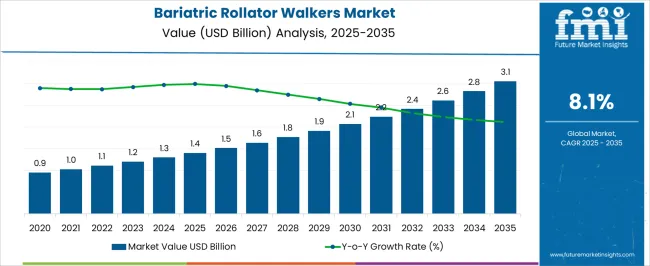
| Metric | Value |
|---|---|
| Bariatric Rollator Walkers Market Estimated Value in (2025 E) | USD 1.4 billion |
| Bariatric Rollator Walkers Market Forecast Value in (2035 F) | USD 3.1 billion |
| Forecast CAGR (2025 to 2035) | 8.1% |
The bariatric rollator walkers market is witnessing steady expansion, supported by the increasing prevalence of obesity-related mobility challenges and the growing geriatric population worldwide. Demand is being reinforced by the need for mobility aids that provide greater stability, weight capacity, and ergonomic support for individuals with higher body mass. Premium designs with advanced features such as reinforced frames, wider seating, and adjustable handles are gaining adoption, as end users and caregivers place a higher emphasis on safety and comfort.
Healthcare providers and rehabilitation centers are also increasingly recommending bariatric rollator walkers due to their ability to reduce fall risk and improve patient independence. Rising awareness about mobility solutions tailored for bariatric patients, combined with supportive reimbursement structures in developed healthcare systems, is fostering wider accessibility.
Technological improvements in lightweight but durable materials are enabling manufacturers to offer stronger yet more user-friendly products As the demand for enhanced mobility solutions grows, the bariatric rollator walkers market is positioned to expand consistently, driven by both clinical requirements and consumer preference for high-quality walking aids.
The bariatric rollator walkers market is segmented by product type, other walking aids, and geographic regions. By product type, bariatric rollator walkers market is divided into Premium Bariatric Rollators and Standard Bariatric Rollators. In terms of other walking aids, bariatric rollator walkers market is classified into Canes, Crutches, and Walkers. Regionally, the bariatric rollator walkers industry is classified into North America, Latin America, Western Europe, Eastern Europe, Balkan & Baltic Countries, Russia & Belarus, Central Asia, East Asia, South Asia & Pacific, and the Middle East & Africa.
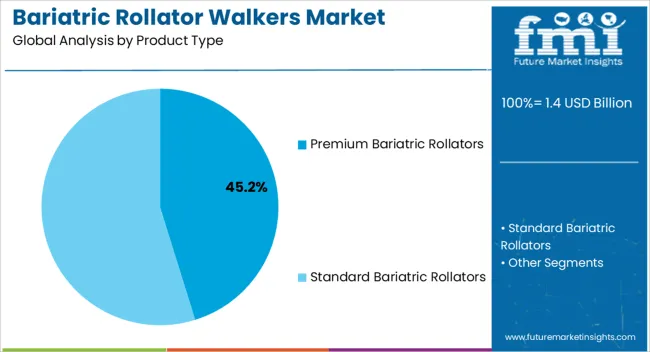
The premium bariatric rollators segment is projected to hold 45.2% of the bariatric rollator walkers market revenue share in 2025, making it the leading product type. Its dominance is being reinforced by the increasing preference for advanced mobility solutions that combine durability with comfort. Premium rollators are designed with enhanced features such as larger weight-bearing capacities, ergonomic grips, and cushioned seating, which significantly improve usability for bariatric patients.
The segment is also benefiting from innovations in frame design, including foldable structures and lightweight alloys that maintain strength while improving portability. Rising demand from healthcare facilities and rehabilitation centers, which prioritize premium-grade solutions for patient safety, is supporting growth. Consumers are also showing greater willingness to invest in higher quality mobility aids, particularly in regions with improved insurance coverage and reimbursement policies.
The emphasis on long-term usability and reduced maintenance needs is further driving adoption As awareness about patient-centric solutions increases and product innovation continues, premium bariatric rollators are expected to maintain their leadership in the global market.
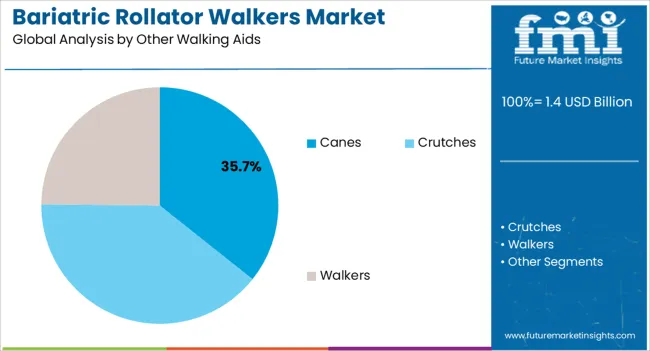
The canes subsegment within the other walking aids category is anticipated to account for 35.7% of the bariatric rollator walkers market revenue share in 2025, positioning it as a significant contributor to segment growth. Canes are being widely adopted due to their affordability, portability, and ease of use, making them an accessible solution for bariatric individuals requiring minimal support. Their compact design allows for convenient daily use both indoors and outdoors, which increases their appeal compared to larger mobility devices.
The segment’s growth is being further supported by advancements in design, such as ergonomic handles, height adjustability, and reinforced structures that ensure durability for bariatric users. Healthcare professionals frequently recommend canes as an entry-level mobility aid before transitioning to rollators or walkers, thereby ensuring consistent demand.
Growing awareness of fall prevention strategies and increasing consumer preference for lightweight walking aids are reinforcing market adoption With the availability of canes across multiple price ranges and their widespread distribution through retail and online channels, this subsegment is expected to retain a strong presence in the overall market.
Bariatrics is a branch of medicine dealing with the study and treatment of obesity and diseases resulting from obesity. In order to reverse the adverse medical conditions resulting from obesity, doctors use methods such as diet control, exercise, lifestyle changes and medical equipment used in home or hospitals. In some cases, medications and surgery are also employed. Obesity is defined as excessive amount of body fat or adipose tissue present in the body as compared with the lean body mass, due to which adverse health conditions arise.
Obesity has become one of the major health issues in the United States in the recent times. Even though there are other industrialized countries where obesity has become a major health scare, in the United States, obesity rates have become amongst the highest in the world.
The magnitude of the problem can be judged by the fact that two out of every three Americans are overweight or obese. Due to this, obesity has contributed to 120,000 preventable deaths in the United States. It is estimated that an obese person in America spends $1429 more in medical expenses annually. The economic cost of this translates to approximately $147 billion that is spend in added medical expenses per year in the United States.
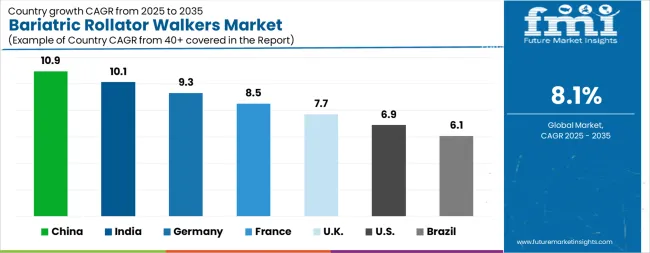
| Country | CAGR |
|---|---|
| China | 10.9% |
| India | 10.1% |
| Germany | 9.3% |
| France | 8.5% |
| UK | 7.7% |
| USA | 6.9% |
| Brazil | 6.1% |
The Bariatric Rollator Walkers Market is expected to register a CAGR of 8.1% during the forecast period, exhibiting varied country level momentum. China leads with the highest CAGR of 10.9%, followed by India at 10.1%. Developed markets such as Germany, France, and the UK continue to expand steadily, while the USA is likely to grow at consistent rates. Brazil posts the lowest CAGR at 6.1%, yet still underscores a broadly positive trajectory for the global Bariatric Rollator Walkers Market. In 2024, Germany held a dominant revenue in the Western Europe market and is expected to grow with a CAGR of 9.3%. The USA Bariatric Rollator Walkers Market is estimated to be valued at USD 530.6 million in 2025 and is anticipated to reach a valuation of USD 1.0 billion by 2035. Sales are projected to rise at a CAGR of 6.9% over the forecast period between 2025 and 2035. While Japan and South Korea markets are estimated to be valued at USD 75.9 million and USD 47.0 million respectively in 2025.
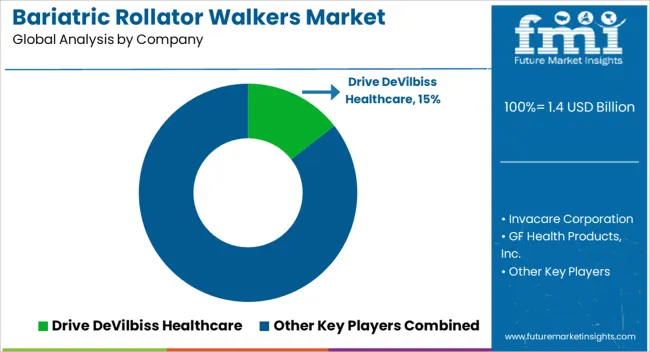
| Item | Value |
|---|---|
| Quantitative Units | USD 1.4 Billion |
| Product Type | Premium Bariatric Rollators and Standard Bariatric Rollators |
| Other Walking Aids | Canes, Crutches, and Walkers |
| Regions Covered | North America, Europe, Asia-Pacific, Latin America, Middle East & Africa |
| Country Covered | United States, Canada, Germany, France, United Kingdom, China, Japan, India, Brazil, South Africa |
| Key Companies Profiled | Drive DeVilbiss Healthcare, Invacare Corporation, GF Health Products, Inc., Karman Healthcare, Medline Industries, Inc., NOVA Medical Products, Sunrise Medical, Briggs Healthcare, Cardinal Health, Dynarex Corporation, Essential Medical Supply, Graham-Field Health Products, Inc., Handicare Group AB, Hoveround Corporation, and Joerns Healthcare LLC |
The global bariatric rollator walkers market is estimated to be valued at USD 1.4 billion in 2025.
The market size for the bariatric rollator walkers market is projected to reach USD 3.1 billion by 2035.
The bariatric rollator walkers market is expected to grow at a 8.1% CAGR between 2025 and 2035.
The key product types in bariatric rollator walkers market are premium bariatric rollators and standard bariatric rollators.
In terms of other walking aids, canes segment to command 35.7% share in the bariatric rollator walkers market in 2025.

Thank you!
You will receive an email from our Business Development Manager. Please be sure to check your SPAM/JUNK folder too.
Chat With
MaRIA